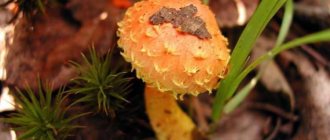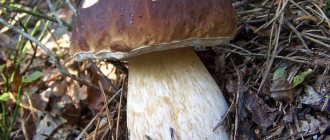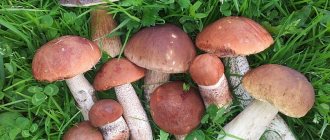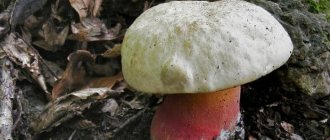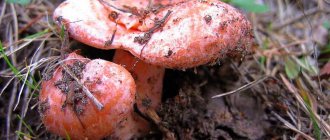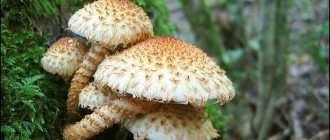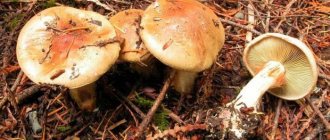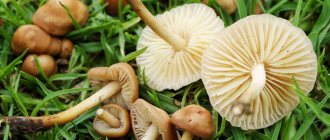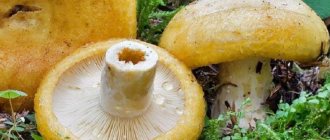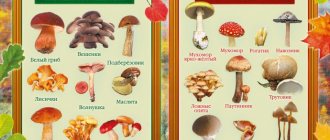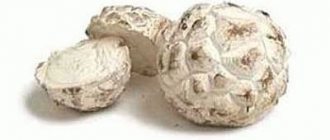Characteristics of the scaly mushroom
hat
— Advertising —
The cap is hemispherical or bell-shaped; as the mushroom matures, it opens to a convex or prostrate cap. The surface is painted in bright colors: yellow, brown or red, rarely dull. Dry or slimy to the touch, scaly, rarely bare.
Pulp
The pulp is fleshy, compact or thin, with a bitter taste.
Leg
— Advertising —
The leg is cylindrical, the surface is dry or mucous, scaly or smooth.
How to cook golden flake
Main courses and marinated preparations are prepared from golden flakes, but only after first boiling the mushrooms for 15-20 minutes. They taste great with meat, potatoes and vegetables. Suitable for preparing stews, fillings for pies and assorted mushrooms. Mushrooms are prepared for the winter table in various ways:
Stewed dishes from royal honey mushrooms with the addition of milk or sour cream have high taste.
How to pickle golden flakes
Marinating golden flake is the most popular way of cooking it. At home, you can prepare canned food that will not be inferior in taste to store-bought.
The algorithm of actions is as follows:
- Mushrooms are cleaned, sorted by size, washed thoroughly and boiled in salted water for 20 - 25 minutes.
- Place in a colander and allow the water to drain.
- Place in prepared, pre-sterilized jars.
- Add cloves, bay leaves, peppercorns, peeled garlic cloves.
- Prepare the marinade: add 2 tbsp to 1 liter of water. l. sugar, 2.5 tbsp. l. non-iodized salt. After boiling, add table vinegar - 4 - 5 tbsp. l.
- The marinade is poured over the prepared flakes and immediately rolled into jars.
How to fry golden flakes with onions
Preparing the easiest and at the same time delicious dish from golden flakes will not take much time, but will provide invaluable benefits to the body. Cooking algorithm:
- Mushrooms brought from the forest are cleaned, washed and boiled in salted water for 20 - 25 minutes.
- The mushroom mass is placed in a colander, the water is allowed to drain completely and placed in a frying pan with vegetable oil.
- Fry over high heat with the lid closed.
- When the moisture has evaporated, add onion rings, salt and pepper.
- Bring the dish to readiness and serve immediately.
Edibility of flakes
The nutritional value of flakes is low, which is why this mushroom is often classified as inedible and is rarely eaten. The most popular and well-known edible species is golden flake, which is rich in vitamins and very tasty; in second place in popularity is herbal flake .
To prevent the flakes from causing digestive problems and indigestion, this mushroom is boiled before use. After that, soups are cooked on its basis, fried, used as a filling for pies and vegetarian pizza, added to vegetable stews and stewed. It is recommended to use only scaly caps; mushroom stems are suitable for pickling. The flakes are also salted and added to salads.
Use in folk medicine
Medicinal products (decoctions, infusions, tinctures) are prepared from foliots, which are used by traditional healers in the treatment of diseases of the cardiovascular system (atherosclerosis, arterial hypertension, varicose veins, thrombophlebitis). Iron and magnesium foliot help increase hemoglobin levels, so introducing these mushrooms into the diet will be useful for anemia and thyroid diseases.
Thanks to the large amount of fiber in the pulp, royal honey mushrooms prevent constipation. The presence of squarrosidine in the pulp of royal mushrooms makes them an indispensable food for people suffering from gout. Moth preparations are used in folk medicine as an emetic and laxative.
Due to its low calorie content, royal mushrooms are included in the diet of diabetics, vegetarians and people on a diet. It has been scientifically proven that fresh golden foliot extract inhibits the growth of Ehrlich carcinoma and sarcoma-180 in laboratory mice.
Types of flakes
Common scaleweed (Pholiota squarrosa)
Edible mushroom.
The cap is 5-12 cm in diameter, hemispherical or conical, later convex and flat-convex, the edge is folded. The surface is covered with dry, bright yellow scales and feels slimy to the touch. The pulp is light yellow, has a weak earthy odor and a rare taste. The leg is 5-19 cm high, 1-3 cm thick, with a fibrous ring, whitish above, reddish-brown below, covered with a dark coating.
A widespread species, it grows on living and dead wood of deciduous and coniferous trees.
Edible scale (Pholiota nameko)
An edible mushroom used in Japanese cuisine for miso soup and pickled. Cultivated in China and Japan.
The cap is small, 1-2 cm in diameter, orange-brown in color, covered with a slippery jelly-like substance. The mushroom grows in groups, on stumps and broad-leaved trees, for example, on beeches, like honey mushrooms; thin legs up to 5 cm high emerge from one base.
Alder scale (Pholiota alnicola)
Edible mushroom.
The cap is 3-7 cm in diameter, the shape is narrowly convex, in mature mushrooms it becomes flat-convex, the edge is bent. The surface is mucous, lemon-yellow, in the central part olive-brown. The pulp is pale yellow, brownish in the stem, has a faint fruity odor, and the taste is mealy and rare. The stem is 3-13 cm high, 0.5-1 cm in diameter, in old mushrooms it is hollow, covered with a white coating, yellow at the top, reddish-brown at the bottom.
A parasitic fungus that grows on dead wood of deciduous trees, alder and willow.
Distribution and collection
The mushroom is truly cosmopolitan, found on almost all continents except Africa and Antarctica. It is found everywhere in deciduous forests, especially with an abundance of old and rotting trees, often on the border with coniferous undergrowth. It grows especially massively in the Far East and China, where it occupies a prominent place in the cuisine. It grows in groups of 3-10 to several dozen mushrooms.
The main harvest time is from early spring to late autumn
Poisonous and inedible types of flake mushroom
Charcoal scaleweed (Pholiota highlandensis)
Inedible mushroom.
The diameter of the cap is 2-6 cm, the shape is convex, then convex-spread. The skin is orange-brown or ocher-brown with a light edge, the surface is sticky, shiny, scaly. The pulp is thin, yellowish-brown in color, taste and smell are not pronounced. The leg is 3-6 cm in height, 0.4-0.8 cm in diameter, cylindrical in shape, thickens towards the base. Yellowish above, dark brown below, scaly.
Distributed in the northern temperate zone, grows in groups from June to early winter.
Fire scale (Pholiota flammans)
Inedible mushroom.
The diameter of the cap is 2.5-7 cm, the shape is hemispherical or conical in a young mushroom, with age it becomes convex and flat-convex, the edge is bent. The surface is covered with dry bright yellow scales, the mucous membrane is yellow-orange in color. The pulp is yellow-orange, brownish in color in the stem, has an earthy odor, and the taste is fresh or bitter. The stem is 3-7 cm high, up to 1 cm thick, in mature mushrooms it is hollow, with a ring, below the ring it is covered with bright yellow scales.
The species is widespread in Eurasia, growing on dead wood of coniferous trees.
Recipes for golden flake dishes
Before preparing the main course, royal honey mushrooms require preliminary cooking. The stems are cut off almost completely, then the mushrooms are soaked for at least 20 minutes to completely remove debris and insects that have gotten into the plates. Then they are boiled in salted water and placed in a colander to drain excess moisture. It is believed that when pre-cooking, it is necessary to put an onion in the pan: if it darkens, then poisonous honey fungus has become “stuck” among the mushrooms. Unfortunately, it is impossible to identify a poisonous individual in this way.
Golden flake recipes:
Pickled honey mushrooms
. The prepared mushrooms are boiled 2 more times for 20 minutes, each time rinsing with running water and adding new water. The jars are sterilized along with the lids, and at this time the marinade is boiled. Proportions: 1 kg of mushrooms, clean water - 600 ml, salt - 2 tablespoons, the same amount of sugar, 12 black peppercorns, 5 bay leaves and 9% vinegar - 2 tablespoons. Boil the marinade for 5 minutes, add 3-4 crushed large cloves of garlic, boil for another 2 minutes. Transfer the mushrooms into jars, pour boiling marinade over them and screw on the lids. The preserved food is left to cool upside down, under a blanket.
Golden flake in sour cream
. Place 1 kg of pre-prepared mushrooms in a colander or paper towels to remove remaining moisture, cut a large onion into rings and fry it in vegetable oil until golden brown. Lay out the mushrooms, fry for 15 minutes, pour half a glass of fatty, preferably country, sour cream into the frying pan, and simmer for 30 minutes. Then sprinkle the roast with chopped herbs - dill and parsley, close the lid and let the dish brew for at least 15 minutes. Serve with fried or boiled potatoes.
Chicken soup with honey mushrooms
. Honey mushrooms are prepared in the usual way, boiling for at least 20 minutes. Finely chop the onions and carrots - it is more convenient to use a blender, since grating the onions will sting your eyes too much. Potatoes are cut into small cubes. It is advisable to finely chop and boil the chicken meat: place the chicken in boiling water, add a whole onion to the container, and boil for 15 minutes. At this time, fry the onion-carrot mixture in a frying pan with sunflower oil, add mushrooms and also fry for 15 minutes. Remove the onion from the chicken broth, add potatoes, fry completely and cook until done. To improve the taste, use bay leaf, black and allspice peppers, and salt. It is better to sprinkle the soup already poured into bowls with herbs.
Royal honey mushrooms in a slow cooker
. In a modern multi-cooker pan, you can pre-cook royal honey mushrooms and prepare the main dish. Place the washed mushrooms in a bowl, set to stew for 30 minutes, and then place on a steamer. While the liquid is draining, chop the onions and carrots. Heat the bowl on the “fry” mode and pour all the ingredients into it together. You can try the dish after 40 minutes - salt, pepper and add herbs to taste.
Salad with golden flake
. Boiled chicken fillet is marinated in soy sauce. Boil the potatoes, cut into cubes, cut the carrots. The pickled mushrooms are washed and cut into equal pieces. Mix potato cubes with carrots, mushrooms and fillet pieces. A large onion is cut into rings, each ring is rolled in flour, fried until golden brown, the parsley is washed and torn by hand. The salad is decorated with fried onion rings and parsley sprigs.
Diet puree soup
. The potatoes are cut, boiled until half cooked, the onions and carrots are sautéed in a frying pan with a minimum amount of sunflower oil. Pre-prepared honey mushrooms are fried together with onions and carrots for 20-25 minutes under a lid. The potatoes are taken out of the water - the broth is not poured out, they are combined with the frying, and crushed with a blender. Bring the water to a boil, add the ground mass into it, mix well and leave to infuse under the lid, pouring in half a glass of heavy cream. Salt to taste, add herbs to each plate.
Golden flakes can be used to prepare filling for pies or add to casseroles. Mushrooms are prepared for the winter not only by pickling, but also by freezing. Pre-treatment of thawed mushrooms is carried out in the same way as fresh ones.
Growing flakes at home
Substrates made from waste from the wood processing industry are suitable for growing flakes, for example, sawdust from deciduous trees, chopped straw with the addition of sunflower husks, wheat bran, and chopped corn cobs.
This substrate is formed into separate blocks, which are sterilized at a temperature of 100°C for 5 hours. Then it is moistened so that the humidity is 65-70%.
The mycelium of the fungus is planted in the substrate under sterile conditions, at temperatures up to 30°C. After which the substrate is left for 2-3 weeks in a room with a temperature of approximately 27°C. Mushrooms do not need lighting during this period, but the air humidity should be 80%. Then the substrate overgrown with mycelium is transferred to a room with an air temperature of up to 11 ° C and a humidity of 98%. At the same time, it is important to ensure normal air exchange; the substrate should not be left in tight bags. When the first rudiments of fruiting bodies appear on the substrate, the air temperature is increased by 5°C, which stimulates the growth of fungi. They also reduce the humidity slightly, by 5-10%. At this time, good lighting is necessary for 10-12 hours a day.
The yield with this growing method is up to 30% of the weight of the original substrate.
In addition, flake is grown on solid wood. Stumps or trunks of deciduous trees are suitable for this. They use aspen, poplar, willow, birch, or fruit trees such as walnut, apple, and plum.
Cuts are made in the wood into which the mycelium is placed. The holes are made using a drill, at a distance of 15 cm from each other. Their depth is about 4 cm, diameter up to 3 cm. You can also split the log lengthwise, pour a thin layer of mycelium into the resulting split, put the halves together and twist them tightly with wire.
When and where are royal honey mushrooms collected?
The main fruiting period for golden scale is in August - September, which is why they are also called autumn royal honey mushrooms. However, in the Primorsky Territory, young mushrooms can be found already at the end of May. Distributed throughout Russia, the CIS countries and Europe, also found in Australia and North America. It is grown on an industrial scale in Japan and China.
Since these are tree mushrooms, royal honey mushrooms grow in small groups on the trunks of living trees, but only on deciduous trees, for example, on willow, birch, and aspen. In fact, they are parasites.
Not only tasty, but also healthy!
Although this species is classified in the fourth category in terms of nutritional value, which is why many Europeans consider them inedible, the Slavs are happy to eat flakes in their diet.
This type of mushroom will not only be a tasty addition to a meal, but also very healthy. Firstly, golden flake is low in calories - 20 kilocalories per 100 grams. And secondly, these mushrooms contain so many vitamins that they can easily compete in usefulness with a product such as fish. They contain many essential amino acids for the human body, iron, magnesium, phosphorus and calcium.
Royal honey mushrooms help with anemia, supplementing the body with minerals, diabetes, thrombophlebitis, regulate the functioning of the thyroid gland, and also increase hemoglobin.
Golden scale
Although willow has many positive qualities, only a few experienced mushroom pickers know about it. The most common golden scale is in China, but this species can also be found in Japan, Russia, North America and some European countries.
As for dishes made from these wonderful mushrooms, they can be used in soups, salads, sauces, used as an addition to a side dish, or simply marinated. Some housewives even add a little mushrooms to the jam for richer flavor.
I would like to note that royal honey mushrooms can be eaten only after boiling for twenty minutes, having previously cleared the honey mushroom from forest debris. The water must be discarded after cooking. The taste of golden flakes is practically no different from the taste of everyone’s favorite honey mushrooms.
Royal honey fungus is an amazing mushroom that has rightfully earned its great name
This representative of the natural kingdom is a desirable delicacy for mushroom pickers, but it is important to be able to distinguish it from other species. An educational article will tell you where to find fruiting bodies and how to prepare them.
Royal honey fungus is an amazing mushroom that has rightfully earned its great name
The golden scale reaches impressive sizes, the wide bell-shaped cap of the described mushroom reaches more than 15 cm in diameter, the color of the fruiting bodies varies from rusty yellow to olive. A distinctive feature of the species is the flaky brown scales, and the flesh of the mushroom is yellowish. The stem is always long; it raises the fruit body by an average of 8 cm above the surface of the wood. Young specimens have a fibrous ring; with age, this part of the fungus disappears.
Young mushrooms that are golden in color are suitable for harvesting; their caps are smooth and slimy to the touch. The darker the fruiting body, the older its age.
Description
Hat . The diameter of the cap of golden mushrooms ranges from 5 to 20 cm. The shape of the cap can be broadly bell-shaped. Over time, it may become flat and round. The color can be dirty golden or rusty yellow. Flake-shaped scales are scattered across the surface of the cap. The color of the plates can be straw, but as they ripen they can take on a brown tint. The flesh of the mushroom is white-yellow in color.
Leg . The length of the mushroom stem is 10 cm, and its diameter is about 1.5 cm. It is quite dense and has a yellow color with brown scales. The stalk has a fibrous ring that may disappear over time.
Similar types and differences from them
The common flake can be confused with other representatives of the foliota – the fiery flake and the golden flake. They are really similar in appearance, both in scales and shape. In addition, their fruiting season may coincide. However, the fiery flake is orange in color, and the golden flake is yellow, whereas, like an ordinary flake, it remains ocher throughout its life.
The taste of fire flake is bitter, unlike golden and ordinary foliot. But even if you can’t deal with them, then there is no need to worry, none of these mushrooms contain poison and you cannot be poisoned by them.
Also, often inexperienced mushroom pickers can mistake the scales for late honey mushrooms, especially adult individuals whose scales are pressed to the surface of the cap.
How to collect correctly
There are no false flakes that are hazardous to health and can be confused with them when collected. The characteristic roughness, easily detectable in most species, always distinguishes mushrooms from poisonous "imitation" mushrooms. Another feature that distinguishes flakes is its bright colors with an admixture of ocher.
Mushrooms are collected according to general rules: carefully cut with a knife, leaving the mycelium in place. After a few weeks, the flakes can be collected again in the same place. Most often, mushrooms appear in mid-summer; sometimes the first foliot families are found in May. The collection continues until late autumn; the mushrooms can withstand even slight frosts.
An unpleasant odor or bitter taste warns that the mushroom is inedible. Toxic types of flakes are distinguished by the broken cap or stem. The pulp changes color when exposed to air, becoming brown. Conditionally edible species are rather pungent in smell and taste; there is no real bitterness in them.
Important! Before consuming flakes in large quantities, it is worth eating a small piece of boiled mushroom to check. After making sure that this species is edible and there is no allergic response from the body for several hours, the product can be introduced into the diet.
Definitioner
Basidia (Basidia)
Lat. Basidia. A specialized structure of sexual reproduction in fungi, unique to basidiomycetes. Basidia are terminal (end) elements of hyphae of various shapes and sizes, on which spores develop exogenously (outside).
Basidia vary in structure and method of attachment to hyphae.
Based on the position relative to the axis of the hyphae to which they are attached, three types of basidia are distinguished:
Apical basidia are formed from the terminal cell of the hypha and are located parallel to its axis.
Pleurobasidia are formed from lateral processes and are located perpendicular to the axis of the hypha, which continues to grow and can form new processes with basidia.
Subbasidia are formed from a lateral process turned perpendicular to the hyphal axis, which stops growing after the formation of one basidium.
Based on morphology:
Holobasidia are single-celled basidia, not divided by septa (see Fig. A, D).
Phragmobasidia are divided by transverse or vertical septa, usually into four cells (see Fig. B, C).
By type of development:
The heterobasidium consists of two parts - the hypobasidium and the epibasidium developing from it, with septations (see Fig. C, B) or without them (see Fig. D).
Homobasidia is not divided into hypo- and epibasidia and in all cases is considered to be holobasidium (Fig. A).
The basidium is the site of karyogamy, meiosis, and the formation of basidiospores. Homobasidy, as a rule, is not functionally divided, and meiosis follows karyogamy. However, the basidia can be divided into probasidium, the site of karyogamy, and metabasidium, the site of meiosis. Probasidium is often a resting spore, for example in rust fungi. In such cases, the probasidium germinates into a metabasidium, in which meiosis occurs and on which basidiospores are formed (see Fig. E).
See Karyogamy, Meiosis, Hypha.
Pileipellis
Lat. Pileipellis, skin - a differentiated surface layer of the cap of agaricoid basidiomycetes. The structure of the skin in most cases differs from the inner flesh of the cap and may have a different structure. The structural features of pileipellis are often used as diagnostic characters in descriptions of fungal species.
Based on their structure, they are divided into four main types: cutis, trichoderma, hymeniderma and epithelium.
See Agaricoid fungi, Basidiomycete, Cutis, Trichoderma, Hymeniderma, Epithelium.
Trichoderma (Trichoderma)
The type of cap skin consists of usually straight, septate elements located more or less perpendicular to the surface and laid both at the same and at different levels; the ends of the hyphae can be morphologically modified and represent dermatocystids. The surface of the cap is velvety to almost felt-like.
Lat. Trichoderm.
Trichoderma is further subdivided into Trichoderma intertwined and Trichoderma irregulara.
Intertwined trichoderma (Intricate trichoderm) is a trichoderma consisting of intertwined hyphae located non-parallel to each other and forming a felt pubescence.
Irregular trichoderm is a trichoderma consisting of irregularly branching hyphae.
See Dermatocystida, Hyphae, Septa.
Kutis
The type of cap skin consists of creeping, ungelatinized hyphae located parallel to the surface. The surface of the cap looks smooth.
Lat. Cutis.
See Hypha.
Common flake (hairy, Pholiotasquarrosa): photo and description, how to cook
| + |
Common scale (or fleecy) Pholiota squarrosa
This somewhat aggressive-looking supposedly “honey fungus” is sometimes called the “royal honey fungus.” Although scaly mushrooms have a very distant relationship with honey mushrooms, mushrooms of different families are similar in their feeding methods: both are parasites and semi-saprophytes.
The mushroom is medium in size, color from pale beige to dirty ocher. At the beginning of growth, the shape of the hat is rounded, almost a ball. Then the cap is extended, a sharp tubercle is indicated in the center, the edges unfold to a diameter of 5-10 cm, rarely more. Densely covered with pointed “rags” slightly darker than the cap itself (well, what would a scale be without them? The name obliges.)
The stem is from 5 to 15 cm, on it the remains of a blanket are visible on young mushrooms, a kind of uneven “skirt”. Below the skirt, the leg looks very disheveled, there are more than enough scales, and they don’t fit, but stick out to the sides. However, it is impossible to inject yourself with them, because soft. The leg becomes somewhat darker towards the base.
The plates, when the opened dome of the cap ceases to hide them, do not look particularly attractive: frequent and adherent, the color of the scale itself, but with a distinct gray tint; by the time the spores mature, they become completely brown.
Common scale grows in small colonies, low on trees or at their very base, on the roots. It can settle on deciduous and coniferous trees, as well as on stumps. Naturally Pholiota squarrosa
harms the forest as a malicious destroyer of wood. And you certainly shouldn’t be happy when you find it in your garden.
People often ask how to distinguish Pholiota squarrosa
from autumn honey mushrooms Armillaria mellea or Armillaria gallica.
In any of the autumn mushrooms, the smooth leg with barely noticeable adjacent dark scales does not reach the “shaggy” scaly leg, over which the epilator cries. The spore powder of honey mushroom is light, while that of Pholiota squarrosa
is brown. And most importantly - the smell. The tasty, subtle honey aroma cannot be compared with the smell of a musty rag emanating from the pulp of the flake. Willy-nilly, the question arises: how do they eat it, and most importantly, why? It’s a tough mushroom, smells musty, and often tastes bitter. Where do these rave reviews come from: “It tastes best when salted and pickled”? Even small unopened mushrooms did not lose their smell after two boils. Alas. Probably, in our forest, the “wrong” trees and the mushrooms that grow on them are changing beyond recognition. I believe that under different conditions (collection area, type of wood), ordinary flake will be more tender and tastier.
Conditionally edible Pholiota squarrosa
However, it does not cause poisoning. Other similar scales (golden and fiery) are also not seen in such outrages.
But how beautiful and photogenic they are! Pleasing the eye from the end of August to the beginning of October, they, non-thorny “hedgehogs,” tell the mushroom picker “Autumn has come.”
